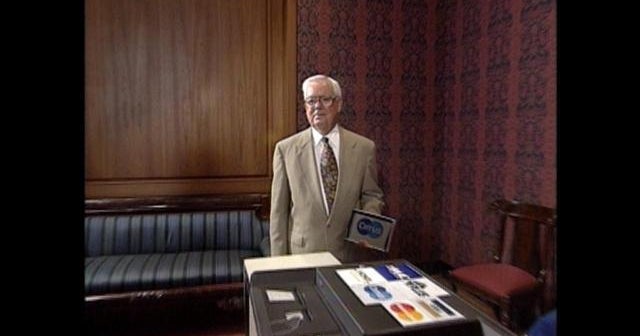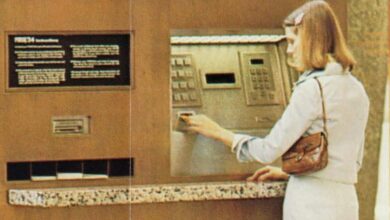From the archive: Celebrating the first ATM

The first ATM, or automated teller machine, was a groundbreaking invention that revolutionized banking. In 1969, Don Wetzel was tired of waiting in line at the bank for a teller, so he came up with the idea of a machine that could dispense cash to customers using personalized cards and PIN codes.
This invention was a game-changer for the banking industry, providing customers with a convenient and efficient way to access their money. To celebrate this innovative creation, the Smithsonian’s National Museum of American History recognized Wetzel and his invention.
In a report originally broadcast on September 20, 1995, correspondent Bill Geist sat down with Wetzel to discuss the inspiration behind the first ATM. Wetzel’s invention paved the way for modern banking practices, making it easier for customers to access their funds without the need for a bank teller.
The first ATM marked a significant turning point in the history of banking, showcasing the power of technology to streamline financial transactions. Today, ATMs are a common sight around the world, offering customers a quick and convenient way to withdraw cash and perform other banking tasks.
As we look back on the invention of the first ATM, we can appreciate the impact it has had on the way we manage our finances. Wetzel’s innovative idea has truly stood the test of time, shaping the future of banking and making everyday transactions easier for millions of people. The invention of the ATM revolutionized the way people interact with their money, providing a convenient and efficient way to access funds without the need for a bank teller. Don Wetzel, the man behind this groundbreaking invention, was recently celebrated by the Smithsonian’s National Museum of American History for his contribution to modern banking.
In a CBS Evening News report from September 20, 1995, correspondent Bill Geist sat down with Wetzel to discuss the origins of the ATM and the impact it has had on society. Wetzel explained that his idea for the ATM came about when he found himself frustrated by long lines at the bank and thought there must be a better way to access cash.
Wetzel’s solution was to create an automated teller machine that would allow customers to withdraw money using a personalized card and a personal identification number (PIN). This innovative concept not only revolutionized the banking industry but also paved the way for the development of modern electronic banking systems.
The ATM quickly gained popularity among consumers for its convenience and accessibility. It allowed people to access their money 24/7, without having to wait in line at the bank. This convenience has become a staple of modern banking, with ATMs now found in almost every corner of the world.
The Smithsonian’s recognition of Wetzel’s invention is a testament to the impact that the ATM has had on society. It has transformed the way people manage their finances and has become an essential tool for millions of people around the world.
As we continue to move towards a cashless society, the ATM remains a vital component of the banking industry. Don Wetzel’s innovative idea has left a lasting legacy, and his contribution to modern banking will always be remembered and celebrated. The world of technology is constantly evolving, with new advancements being made every day. One of the most exciting developments in recent years has been the rise of artificial intelligence (AI). AI is changing the way we live and work, and its potential is seemingly limitless.
One area where AI is making a big impact is in the field of healthcare. From diagnosing diseases to improving patient care, AI is revolutionizing the way medical professionals work. One of the key benefits of AI in healthcare is its ability to analyze vast amounts of data quickly and accurately. This means that doctors can make more informed decisions and provide better care to their patients.
AI is also being used to develop new treatments and therapies for a wide range of conditions. For example, researchers are using AI to analyze genetic data and identify potential new drug targets. This could lead to the development of more personalized treatments that are tailored to an individual’s genetic makeup.
In addition to improving patient care, AI is also helping to streamline healthcare operations. By automating routine tasks and processes, AI is freeing up medical professionals to focus on more complex and important work. This is helping to reduce wait times for patients and improve overall efficiency in healthcare facilities.
But AI is not just limited to the healthcare industry. It is being used in a wide range of other sectors, from finance to transportation to retail. In finance, AI is being used to improve fraud detection and automate trading processes. In transportation, AI is helping to develop autonomous vehicles that could revolutionize the way we travel. And in retail, AI is being used to personalize the shopping experience and improve customer service.
Despite its many benefits, AI also raises some important ethical and societal questions. For example, there are concerns about the potential impact of AI on jobs, as automation could lead to job losses in certain industries. There are also concerns about privacy and data security, as AI relies on vast amounts of data to function effectively.
Overall, the rise of AI is an exciting development that has the potential to transform our world in countless ways. As we continue to unlock the full potential of this technology, it will be important to carefully consider the ethical and societal implications to ensure that AI is used responsibly and for the greater good. The world of technology is constantly evolving, with new advancements being made every day. From smartphones to artificial intelligence, there is no shortage of innovation in the tech industry. One of the most exciting developments in recent years is the rise of virtual reality (VR) technology.
Virtual reality is a computer-generated simulation of a three-dimensional environment that can be interacted with in a seemingly real or physical way by a person using special electronic equipment, such as a headset. This technology has the potential to revolutionize the way we experience entertainment, education, and even healthcare.
One of the most popular uses of virtual reality is in the gaming industry. VR games allow players to step into a virtual world and interact with their surroundings in a way that was previously impossible. From immersive first-person shooters to realistic racing simulators, the possibilities are endless when it comes to gaming in VR.
But virtual reality is not limited to just entertainment. In the field of education, VR can be used to create immersive learning experiences that engage students in a way that traditional methods cannot. For example, students studying history can virtually visit ancient civilizations, while those studying science can explore the depths of the ocean or outer space.
In healthcare, virtual reality is being used to train medical professionals in complex surgical procedures and to help patients manage chronic pain. VR therapy has also been shown to be effective in treating a variety of mental health conditions, such as PTSD and anxiety disorders.
As virtual reality technology continues to improve and become more accessible, the possibilities for its use are endless. From creating virtual tours of real estate properties to allowing remote workers to collaborate in virtual office spaces, VR has the potential to revolutionize the way we live, work, and play.
Overall, virtual reality technology is changing the way we experience the world around us. With its ability to create immersive and interactive environments, VR has the potential to transform a wide range of industries and improve the way we learn, work, and connect with others. The future of virtual reality is bright, and we can’t wait to see where this exciting technology takes us next. The global pandemic has had a significant impact on businesses around the world, with many industries struggling to survive in the face of lockdowns and restrictions. As businesses continue to navigate the challenges brought on by the pandemic, it is important for companies to adapt and innovate in order to stay afloat.
One industry that has been hit particularly hard by the pandemic is the hospitality industry. With travel restrictions in place and people staying home to prevent the spread of the virus, hotels, restaurants, and other hospitality businesses have seen a significant decrease in revenue. Many businesses have had to close their doors permanently, while others have had to lay off employees in order to survive.
However, despite the challenges facing the hospitality industry, some businesses have been able to adapt and find new ways to stay afloat during these difficult times. One such example is the rise of virtual events and experiences in the hospitality industry. With in-person events and gatherings on hold, many businesses have turned to virtual platforms to offer their services and connect with customers.
Virtual events have become increasingly popular in the hospitality industry, with businesses offering virtual tours, cooking classes, wine tastings, and other experiences online. These virtual events not only provide businesses with a new revenue stream, but also allow them to reach a wider audience and connect with customers in a new and innovative way.
In addition to virtual events, many businesses in the hospitality industry have also shifted their focus to takeout and delivery services. With restaurants unable to offer in-person dining, many have pivoted to offering takeout and delivery options in order to continue serving customers. Some restaurants have even partnered with delivery apps to expand their reach and bring their food to a wider audience.
Another innovative trend in the hospitality industry is the rise of outdoor dining. With indoor dining restrictions in place, many restaurants have expanded their outdoor seating areas in order to accommodate more customers. Some businesses have even invested in outdoor heating and lighting to make their outdoor dining spaces more comfortable for guests.
Overall, the pandemic has presented numerous challenges for businesses in the hospitality industry. However, through innovation and adaptation, many businesses have been able to find new ways to stay afloat during these difficult times. From virtual events and experiences to takeout and delivery services, businesses in the hospitality industry are proving that they can weather the storm and come out stronger on the other side.




